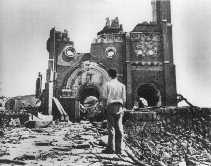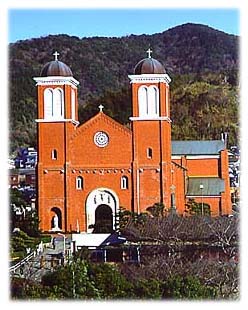 In Nagasaki, the Urakami Cathedral — a Romanesque-style building of brick and stone — was completed in 1925 after some 30 years of work. It was the largest church in the Orient.
In Nagasaki, the Urakami Cathedral — a Romanesque-style building of brick and stone — was completed in 1925 after some 30 years of work. It was the largest church in the Orient.Christianity was introduced to Japan in 1549 when Portuguese Jesuit priests, led by Francis Xavier, began missionary work on the southern island of Kyushu where Nagasaki is located. Local warlords granted the Jesuits freedom to preach and establish small churches in exchange for the profits to be gained from trade. Through the heroic labors of the missionaries, Christianity spread quickly through the whole country.
A military ruler of a reunified Japan, Ieyasu Tokugawa, fearing domination from the influence exerted by the Portuguese, ordered the missionaries to leave Japan in 1587. The first sudden storm of persecution came ten years later on February 5, 1597, when 26 priests and laypersons were crucified at Nagasaki. The martyrs, Paul Miki S.J. and companions, were canonized by Pope Pius IX in 1862. A monument honoring them is the second largest monument in Nagasaki after the Peace Park.
Following a decade-long respite in the persecution, a new expulsion order was issued in 1614, and within one year all churches and missionary centers were destroyed. A long campaign of exile, imprisonment, and torture to stamp out Christianity began in earnest. Estimates of the number of Christians in Japan at the time range up to 750,000. More than 4,000 are estimated to have sacrificed their lives for their faith during the persecution. Pope Pius IX beatified 205 of them, including 166 from Nagasaki, in 1867.
In 1639, Japan retreated into a state of isolation for two centuries until 1853-1854, when Commodore Matthew Perry of the U.S. Navy induced Japan to reopen its doors to foreigners. Subsequently in 1865, a priest of the Paris Foreign Mission Society discovered in Nagasaki a group of descendants of 17th-century Catholics who had preserved their faith for two centuries in secret, despite persecutions and lack of priests. Later discoveries revealed that there were more than 15,000 such Catholics on Kyushu. Although a new outbreak of persecution ensued from 1867 to 1873, religious freedom was granted tentatively in 1873 and permanently in 1889.
 In Nagasaki, the Urakami Cathedral — a Romanesque-style building of brick and stone — was completed in 1925 after some 30 years of work. It was the largest church in the Orient.
In Nagasaki, the Urakami Cathedral — a Romanesque-style building of brick and stone — was completed in 1925 after some 30 years of work. It was the largest church in the Orient.
During World War II, many churches, convents, and schools were destroyed. The war came to an abrupt end after atomic bombs were exploded on Hiroshima on August 6, 1945, and on Nagasaki on August 9, 1945. The Nagasaki bomb, fueled with plutonium from Hanford, was dropped through an opening in the clouds onto the Urakami Catholic district, and the Urakami Cathedral was destroyed (photo).
 In 1985, the 40th anniversary of the atomic bombing, the
then-mayor of Nagasaki, Hitoshi Motoshima, sent as a gift to the City of Richland a model
of the "Bell of Peace" — the Angelus bell from the original Urakami
Cathedral. The "Bell of Peace" model — on
display in the Richland Public Library — is used
each August 9th in the Atomic Cities Peace Memorial ceremony in Richland. In
accordance with the Memorial's theme of reconciliation, the bell is rung for those who
died on both sides of the war — for the
Americans who died at Pearl Harbor as well as for the Japanese who died in Hiroshima and
Nagasaki.
In 1985, the 40th anniversary of the atomic bombing, the
then-mayor of Nagasaki, Hitoshi Motoshima, sent as a gift to the City of Richland a model
of the "Bell of Peace" — the Angelus bell from the original Urakami
Cathedral. The "Bell of Peace" model — on
display in the Richland Public Library — is used
each August 9th in the Atomic Cities Peace Memorial ceremony in Richland. In
accordance with the Memorial's theme of reconciliation, the bell is rung for those who
died on both sides of the war — for the
Americans who died at Pearl Harbor as well as for the Japanese who died in Hiroshima and
Nagasaki.
In 1959, construction of a new Urakami Cathedral (photo) was completed. The Angelus "Bell of Peace" continues to ring out from the reconstructed church overlooking the Peace Park: Bong! ... Bong! ... Bong!